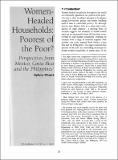| dc.contributor.author | Chant, Sylvia | en |
| dc.date.accessioned | 2016-02-24T15:32:00Z | |
| dc.date.available | 2016-02-24T15:32:00Z | |
| dc.date.issued | 01/07/1997 | en |
| dc.identifier.citation | Chant, S. (1997) Women-Headed Households: Poorest of the Poor? IDS Bulletin 28(3): 26-48 | en |
| dc.identifier.issn | 1759-5436 | en |
| dc.identifier.uri | https://opendocs.ids.ac.uk/opendocs/handle/20.500.12413/9205 | |
| dc.description.abstract | Women-headed households are commonly regarded as the ‘poorest of the poor’. Not only do they seem to be disproportionately concentrated among low-income groups, but female headship itself is seen to exacerbate poverty. Yet a growing body of research on developing societies suggests that although poverty may precipitate the formation of female?headed households, and that some aspects of female headship can give rise to economic disadvantage, members of these units are not necessarily worse-off than people in male?headed domestic arrangements. With reference to case study material from Mexico, Costa Rica and the Philippines, this article argues that ‘poorest of the poor’ is a misleading stereotype for female-headed households, that we cannot generalise about female heads, and that examination of intra-household characteristics is essential for the understanding of economic vulnerability. The article also signposts the dangers of ‘poorest of the poor’ stereotyping for creating and/or reinforcing negative public images of, and attitudes towards, women-headed households. | en |
| dc.format.extent | 23 | en |
| dc.publisher | Institute of Development Studies | en |
| dc.relation.ispartofseries | IDS Bulletin Vol. 28 Nos. 3 | en |
| dc.rights.uri | http://www.ids.ac.uk/files/dmfile/IDSOpenDocsStandardTermsOfUse.pdf | en |
| dc.title | Women-Headed Households: Poorest of the Poor? | en |
| dc.type | Article | en |
| dc.rights.holder | © 1997 Institue of Development Studies | en |
| dc.identifier.doi | 10.1111/j.1759-5436.1997.mp28003003.x | en |

